Balbharti Maharashtra State Board Class 8 History Solutions Chapter 9 Last Phase of Struggle for Independence Notes, Textbook Exercise Important Questions and Answers.
Class 8 History Chapter 9 Last Phase of Struggle for Independence Questions And Answers Maharashtra Board
Last Phase of Struggle for Independence Class 8 Questions And Answers Chapter 9 Maharashtra Board
Class 8 History Chapter 9 Last Phase of Struggle for Independence Textbook Questions and Answers
1. Rewrite the statements by choosing the appropriate options :
(Andaman and Nicobar, August Kranti, Vinoba Bhave, Sane Guruji, Indian National Congress)
Question 1.
……………….. was the first satyagrahi of individual satyagraha.
Answer:
Vinoba Bhave
![]()
Question 2.
The nation wide movement of 1942 is also called ……….. .
Answer:
August Kranti
Question 3.
In November 1943, Japan conquered ………. islands and handed them over to Azad Hind Government.
Answer:
Andaman and Nicobar
2. Explain the following statements with reasons:
Question 1.
In November 1939, provincial ministers of Indian National Congress gave their resignations.
Answer:
- Viceroy Lord Linlithgo declared in 1939 that India had joined the Second World War on the side of England, without consulting the Indian leaders.
- England claimed that it was fighting to save democracy in Europe.
- Thereupon, the Congress claimed that if that claim is true then England should grant Independence to India immediately. ’
- So the provincial ministries of the Indian National Congress resigned in November 1939 as England did not accept this demand.
Question 2.
The Indian National Army had to lay down their arms.
Answer:
- The Indian National Army fought against the British in adverse circumstances under the leadership of Subhash Chandra Bose.
- The Imphal Campaign of Indian National Army remained incomplete as the Japanese stopped helping the Indian National Army.
- In the same period, Japan accepted defeat in the Second World War.
- On 18 August 1945, Subhash Chandra Bose died in a plane crash.
Under these circumstances, the soldiers of the Indian National Army had to lay down their arms.
![]()
Question 3.
The Parallel Government became a source of inspiration to the people.
Answer:
1. During the Quit India Movement, parallel governments were established in many parts of India.
2. It rendered great service by doing work like :
- Opposition to money lenders
- Prohibition of liquor
- Spread of literacy
3. Opposition to caste distinctions, etc. Due to this, the Parallel Government became a source of inspiration for the public.
3. Complete the following table.
Question 1.

Answer:
| Organisation | Founder |
| Forward Bloc | Subhash Chandra Bose |
| Indian Independence League | Rash Behari Bose |
| Toofan Sena | Krantiagrani G.D. alias Bapu Lad |
4. Answer the following questions in brief:
Question 1.
Why did the British Prime Minister send Sir Stafford Cripps to India?
Answer:
- During the Second World War, England sided with America against Japan.
- As England was ruling India, there was possibility of Japan attacking India.
- The Japanese forces came closer to the eastern border of India.
- It was necessary to have co-operation of India to resist Japanese invasion.
Therefore, the British Prime Minister, Winston Churchill sent Sir Stafford Cripps to India in March 1942.
![]()
Question 2.
What kind of reaction was seen during the spread of news of arrest of main leaders of the Indian National Congress?
Answer:
- Quit India Resolution moved by Pandit Jawaharlal Nehru, was passed on 8th August with an overwhelming majority.
- On the same night, the leaders of the Indian National Congress were arrested.
- The news of these arrest aroused strong resentment.
- The angry people took out processions, tried to take control of government offices and attacked jails, police stations and railway stations.
- School children took out processions and shouted slogan “Vande Mataram”.
- Even though the police resorted to lathi charge and firing, the people were not afraid. The young and old showed determination and courage.
Question 3.
What appeal did Mahatma Gandhi make in the Quit India session of Indian National Congress?
Answer:
Gandhiji made the following appeal to the people of India during the Quit India session of Indian National Congress at Mumbai:
- Everyone of you, should from this moment onwards, consider yourself a free man or woman.
- Everyone should behave like a citizen of free India.
- Either we shall free India or die in the attempt.
- Through the appeal he stated that Indians should be ready to make a sacrifice with the feeling of ‘Do or Die’.
Do you Know?
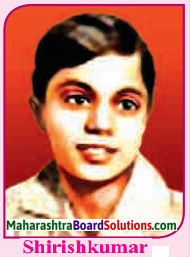
Inspirational account of brave children:
- Under the leadership of Shirishkumar, school children carried out procession holding the tricolour at Nandurbar in Maharashtra.
- The slogan of Vande Mcrtaram was given.
- In the police firing, along with Shirishkumar, Dhansukhlal, Shashidhar, Ghanashyam, Laldas became martyrs.
![]()
Let us Know….:
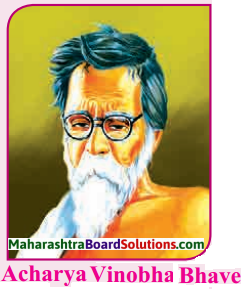
Individual Satyagraha:
- As the British government was constantly neglecting the demands, the Indian National Congress decided to start anti war propaganda.
- Instead of a collective movement every person should individually disobey the law. This is called Individual Satyagraha.
- Acharya Vinoba Bhave was the first individual Satyagrahi.
- After him, nearly 25,000 Satyagrahis participated in individual Satyagraha and were imprisoned.
Project:
Question 1.
Prepare a timeline of the events of the struggle of Indian National Army.
Question 2.
With the help of internet collect the pictures of Quit India Movement of 1942 and organise an exhibition on occasion of a national day.
Class 8 History Chapter 9 Last Phase of Struggle for Independence Additional Important Questions and Answers
1. Rewrite the statements by choosing the appropriate options :
Question 1.
Provincial Ministers of …………… resigned in November, 1939.
Answer:
Indian National Congress
Question 2.
Songs of ……………. inspiration during the movement.
Answer:
Sane Guruji
![]()
Identify the wrong pair :
Organisation – Founder
1. Azad Dasta – Bhai Kotwal
2. Lai Sena – General Awari
3. Azad Radio – Aruna Asaf Ali
4. Azad Hind Government – Subhash Chandra Bose
Answer:
Wrong pair: Azad Radio
– Aruna Asaf Ali
Corrected pair: Azad Radio
– Usha Mehta.
Rewrite the statements by choosing the appropriate options :
Question 1.
In 1937 elections, the Indian National Congress gained a majority in ……………
provinces and came to power.
(a) seven
(b) two
(c) eight
(d) three
Answer:
(c) eight
Question 2.
Parallel government was formed by …………… in Satara.
(a) Krantisinh Nana Patil
(b) N.G. Gore
(c) Rashtrasant Tukdoji Maharaj
(d) S.M. Joshi
Answer:
(a) Krantisinh Nana Patil
Question 3.
Netaji founded the …………… in 1943 in Singapore.
(a) Free India Centre
(b) Azad Hind Sena
(c) Parallel Government
(d) Azad Hind Government
Answer:
(d) Azad Hind Government
Question 4.
…………… tried to destroy the railway along with his campaigners in Sindh.
(a) Khudiram Bose
(b) Ashfaqulla Khan
(c) Hemu Kalani
(d) Maganlal Bagdi
Answer:
(c) Hemu Kalani
![]()
Question 5.
…………… had formed the Azad Hind Sena with the help of Captain Mohan Singh.
(a) Rash Behari Bose
(b) Subash Chandra Bose
(c) Anand Mohan Bose
(d) S.M. Gore
Answer:
(a) Rash Behari Bose
Name the following:
Question 1.
Viceroy who announced India’s involvement in Second World War.
Answer:
Lord Linlithgo
Question 2.
President of Mumbai session of Indian National Congress.
Answer:
Maulana Abul Kalam Azad
Question 3.
Leader who put forth Quit India Movement resolution at the Mumbai session of the Congress.
Answer:
Pandit Jawaharlal Nehru
Question 4.
The outburst of Navy and Air Force on this British warship.
Answer:
Talwar
Question 5.
His songs inspired the National Movement.
Answer:
Rashtrasant Tukdcji Maharaj.
Answer the following in one sentence each:
Question 1.
State the resolution passed by the Congress Working Committee in the Wardha session.
Answer:
The Congress Working Committee at its Wardha session passed the resolution that
- the British rule in India should be ended immediately and
- India be given independence.
Question 2.
What was the warning given by the Congress Working Committee in the Wardha session?
Answer:
The Congress Working Committee had given the warning that if the demand for complete independence was not met, it would launch a non-violent movement for the freedom of India.
![]()
Question 3.
Why did the British Government imprison Subhash Chandra Bose?
Answer:
The British Government imprisoned Subhash Chandra Bose because through his speeches he made appeal to the people of India to revolt against the British rule.
Question 4.
What did the British Government realise after the Navy and Air Force revolted?
Answer:
After the revolt of Navy and Air Force, the British Government realised that their rule in India was about to end.
Do as Directed:
Complete the graphical presentation:
Question 1.
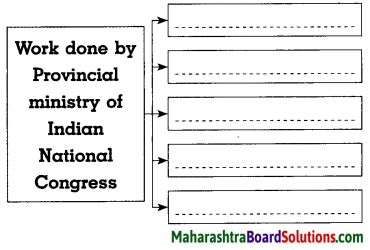
Answer:
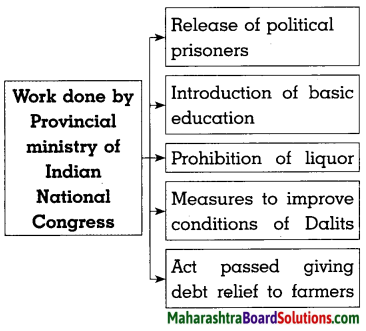
Question 2.
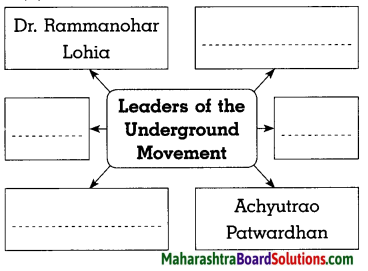
Answer:
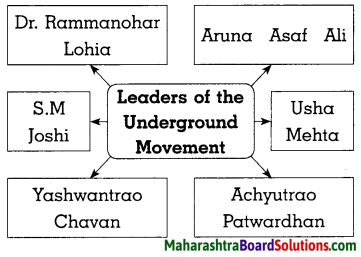
Question 3.
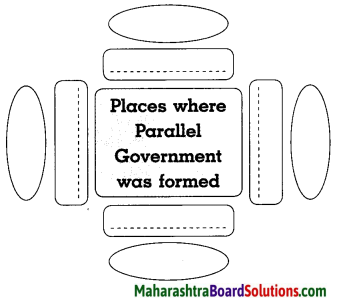
Answer:
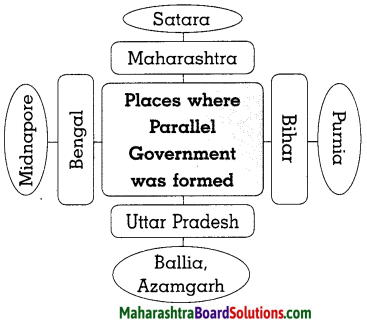
Question 4.
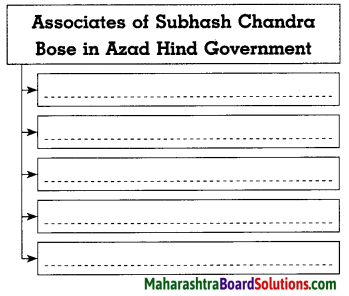
Answer:
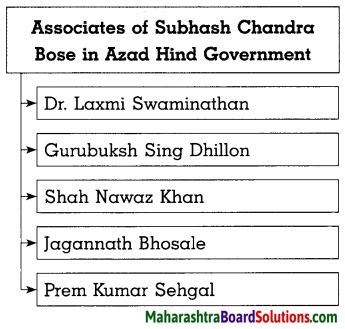
Prepare a Timeline of the events of the struggle of Azad Hind Sena:
Question 1.

Answer:
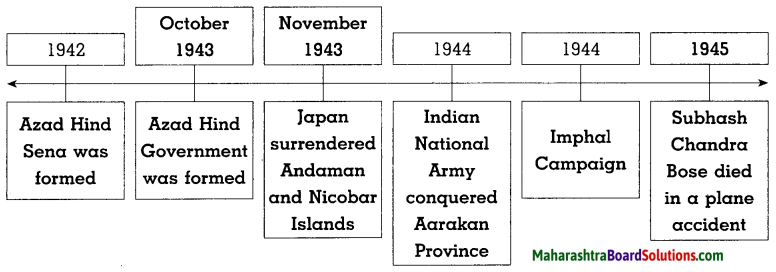
Write short notes :
Question 1.
Provincial Cabinets :
Answer:
- According to the Act of 1935, working of the British administered provinces were transferred to the elected representatives.
- Although not satisfied with the act. Congress contested elections to the Provincial Legislatures of eleven provinces in 1937.
- Indian National Congress gained a majority in eight provinces.
- Congress ministries did a lot of useful work for the benefit of the people.
- As the British government refused their demand of Independence the Congress ministries resigned in November 1939.
![]()
Question 2.
Individual Satyagraha :
Answer:
- As the British government was constantly neglecting the demands the Indian National Congress decided to start anti-war propaganda.
- Instead of a collective movement they decided every person should individually disobey the law. This is known as Individual Satyagraha.
- Acharya Vinoba Bhave was the first Individual Satyagrahi.
- After him nearly 25,000 satyagrahis participated in individual satyagraha and were imprisoned.
Question 3.
Rash Behari Bose :
Answer:
- Rash Behari Bose was living in Japan since 1915.
- He had established the ‘Indian Independence League’ by organizing the Indian patriots living in the South East Asia.
- Japan conquered the territories of South-East Asia controlled by the British.
- Rash Behari Bose, with the help of Captain Mohan Singh, formed the Indian
National Army or Azad Hind Sena from the Indian prisoners of war captured by Japan.
Question 4.
Revolt of Indian Navy and Air Force :
Answer:
- Inspired by the heroics of the Indian National Army, the soldiers on the British warship ‘Talwar’ revolted on 8th February 1946.
- They hoisted the tricolour flag on the ship and raised slogans against the British Government.
- The exchange of fire between the rebels and the British army took place.
- The workers and common people extended their support.
- To support this uprising, the Air Force from Delhi, Lahore, Karachi, Ambala, Meerut went on strike.
- The naval soldiers laid down their arms after the mediation by Sardar Vallabhbhai Patel.
Answer the following questions in brief:
Question 1.
What work did the Azad Radio Centre do during the 1942 underground movement?
Answer:
During the 1942 underground movement Vitthal Zaveri, Usha Mehta and her companions established a secret transmission centre, ‘Azad Radio’.
The work done:
- News of agitations in the country were broadcast on it.
- Patriotic songs were sung.
- Patriotic speeches were telecast.
This gave inspiration to the agitators during the Quit India Movement.
![]()
Question 2.
Explain the significance of the Quit India Movement.
Answer:
1. On 8th August 1942, in the Mumbai session, the Indian National Congress gave the order of ‘Quit India’ to the British government. This was the beginning of a nationwide agitation.
2. To fulfill the objective of independence, lakhs of Indians sacrificed their lives in this movement.
3. The number of people who participated were so large that even all prisons in the country were not enough to contain them.
4. The movement shook the foundation of British rule in India.
Question 3.
State the impact of the events from 1942 to 1946 on the British rule.
Answer:
Many important events took place between 1942 to 1946. The following effects were seen on the British rule :
- It shook the foundation of British rule in India.
- The Quit India agitation manifested the strong anti-British feeling of the Indian people.
- The Army, Navy and Air Force considered to be backbone of the British power revolted against it.
- The British rulers realised that now their rule will not last long in India.
Explain the following statements with reasons:
Question 1.
The plan of federation mentioned in 1935 Act did not materialise.
Answer:
- The Act of 1935 provided for the formation of a federation of the British administered provinces and the Indian princely states.
- The working of the British administered provinces were transferred to the Indian representatives.
- On joining the federation, the princely states would lose their autonomy.
- So, the proposal of federation did not materialise as the rulers of the princely states refused to join the federation.
Question 2.
The Cripps proposal was rejected.
Answer:
- The Indian National Congress rejected the Cripps’ proposal because there was no clear mention of the grant of complete independence to India.
- The Muslim League rejected the Cripps’ proposal as it had no mention of creation of Pakistan.
![]()
Question 3.
Subhash Chandra Bose resigned from the office of Congress President.
Answer:
1. Subhash Chandra Bose became the President of Indian National Congress twice.
2. He became the President of Congress when Second World War had commenced. He was of the opinion that as England was engaged in war, the Congress should intensify the agitation by taking advantage of this situation.
3. If needed, India should seek the help of the enemies of England.
4. Other senior leaders of the Congress did not agree with this view.
As a result, Subhash Chandra Bose resigned from the office of the Congress President.
Question 4.
The British government suspended the punishment of INA officers.
Answer:
- After surrender of the soldiers of the Indian National Army, the British government charged them with treason.
- Expert lawyers like Pandit Nehru, Bhulabhai Desai and Tej Bahadur Sapre defended the INA officers.
- But the military tribunal held them guilty and sentenced them to life imprisonment.
- There was severe unrest in the minds of the Indian people against the British Government.
So, they had to suspend the punishment given by the military tribunal.
Answer the following in detail:
Question 1.
Write about the Session of Indian National Congress held in Mumbai in August 1942.
Answer:
- On 14th July, 1942 the Congress Working Committee passed the Quit India Resolution at Wardha.
- It warned the British government of launch of a non-violent struggle for India’s independence.
- With this background, Quit India Session of the Indian National Congress began at Gowalia Tank (Kranti Maidan) in Mumbai on 7th August, 1942.
- Maulana Abul Kalam Azad presided over this session.
- The resolution passed at Wardha § session was finally approved in the Mumbai session.
- On 8th August, Quit India Resolution, moved by Pandit Jawaharlal Nehru was passed with an overwhelming majority.
- Congress decided to launch a nationwide non-violent movement under the leadership of Gandhiji.
- Gandhiji gave inspiring message of ‘Do or Die’ to the people and appealed them to be ready to sacrifice for the nation.
![]()
Question 2.
Give detailed information about Underground Movement.
Answer:
- At the end of 1942, the young socialist leaders started the Underground Movement.
- S. M. Joshi, Dr. Ram Manohar Lohia, Jayprakash Narayan were among the many leaders who led the movement.
- Aruna Asaf Ali, Usha Mehta, Sucheta Kriplani were the women leaders who led the movement.
- The activists disrupted transport and communication by breakdown of railway routes, cutting telephone lines, blowing up 8 bridges, etc.
- Hemu Kalani tried to destroy railway carrying British troops and supply, in Sindh province.
- Groups like Azad Dasta of Bhai Kotwal in Karjat and Lai Sena of General Awari in Nagpur made the government helpless and witless for months.
- Usha Mehta and Vitthal Zaveri started a secret transmission centre of Azad Radio in Mumbai.
- Many such centres operated at Kolkata, Delhi and Pune.
- Krantisinh Nana Patil formed parallel government in Satara.
- Parallel governments were formed in Midnapore in Bengal, Ballia and Azamgrah in Uttar Pradesh and Purnia in Bihar.
- Krantiagrani GD (Bapu Lad) established ‘Toofan sena’ at Kundal.
Question 3.
Identify the given picture and write information about the work done by him.
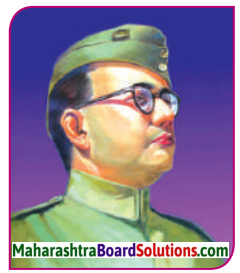
Answer:
The given picture is of Netaji Subhash Chandra Bose.
- Subhash Chandra Bose became the President of Indian National Congress twice.
- He was of the view to intensify the agitation and seek help from the enemies of England during the Second World War.
- He had difference of opinion with other senior leaders on these points.
- Therefore, he resigned from the office of the Congress President and formed a party, ‘Forward Bloc’.
- Subhash Chandra Bose was imprisoned by the British because he made an appeal to the people of India to revolt against the British.
- He was interned in his house by the British but he managed to escape in disguise and reached Germany in April 1941.
- He founded the ‘Free India Centre’ in Germany.
- He made an appeal to the people of India to join in the armed struggle for the independence of India from Berlin radio station.
- On the invitation of Rash Behari Bose, he went to Japan and led the Indian National Army.
- He formed the Azad Hind Government in Singapore in 1943.
- Under his leadership, Azad Hind Army captured the Aarakan province in Myanmar and posts on the eastern border of Assam.
- Netaji appealed to the people of India : ‘You give me blood and I will give you independence’.
- On 18 August, 1945 Netaji died in a plane crash.
![]()
Question 4.
How do you find the contribution of Shirishkumar to be inspirational?
Answer:
- Under the leadership of Shirishkumar, the school children took out a procession holding the tricolour flag at Nandurbar.
- ‘Vande Mataram’ was the slogan given to them.
- The police fired on them. In the firing Shirishkumar and many other children became martyrs.
- His sacrifice gives inspiration to us to do work for the society and country.
- Gaining independence is no more our objective but to keep the environment clean, to maintain unity among people, and collectively solve the problems is our responsibility.
- As all this is equally challenging we get inspiration from courage and determination of Shirishkumar.
- Shirishkumar inspires us to do our work fearlessly without being a victim of injustice and oppression.
- He also inspires us to make sacrifice, have faith in work and determination. 1
8th Std History Questions And Answers:
- Sources of History Class 8 History Questions And Answers
- Europe and India Class 8 History Questions And Answers
- Effects of British Rule Class 8 History Questions And Answers
- The Freedom Struggle of 1857 Class 8 History Questions And Answers
- Social and Religious Reforms Class 8 History Questions And Answers
- Beginning of Freedom Movement Class 8 History Questions And Answers
- Non-co-operation Movement Class 8 History Questions And Answers
- Civil Disobedience Movement Class 8 History Questions And Answers
- Last Phase of Struggle for Independence Class 8 History Questions And Answers
- Armed Revolutionary Movement Class 8 History Questions And Answers
- Struggle for Equality Class 8 History Questions And Answers
- India Gains Independence Class 8 History Questions And Answers
- Fulfillment of Struggle for Independence Class 8 History Questions And Answers
- Formation of State of Maharashtra Class 8 History Questions And Answers